- February 24, 2010: Part 1
- Part 2
- Part 3
- Part 4
- Abbreviations
- Printable Version (927 KB PDF)

Sections of Part 4
Part 4: Summary of Economic Projections
Monetary Policy Report submitted to the Congress on February 24, 2010, pursuant to section 2B of the Federal Reserve ActThe following material appeared as an addendum to the minutes of the January 26-27, 2010, meeting of the Federal Open Market Committee.
In conjunction with the January 26-27, 2010, FOMC meeting, the members of the Board of Governors and the presidents of the Federal Reserve Banks, all of whom participate in deliberations of the FOMC, submitted projections for output growth, unemployment, and inflation for the years 2010 to 2012 and over the longer run. The projections were based on information available through the end of the meeting and on each participant's assumptions about factors likely to affect economic outcomes, including his or her assessment of appropriate monetary policy. "Appropriate monetary policy" is defined as the future path of policy that the participant deems most likely to foster outcomes for economic activity and inflation that best satisfy his or her interpretation of the Federal Reserve's dual objectives of maximum employment and stable prices. Longer-run projections represent each participant's assessment of the rate to which each variable would be expected to converge over time under appropriate monetary policy and in the absence of further shocks.
FOMC participants' forecasts for economic activity and inflation were broadly similar to their previous projections, which were made in conjunction with the November 2009 FOMC meeting. As depicted in figure 1, the economic recovery from the recent recession was expected to be gradual, with real gross domestic product (GDP) expanding at a rate that was only moderately above participants' assessment of its longer-run sustainable growth rate and the unemployment rate declining slowly over the next few years. Most participants also anticipated that inflation would remain subdued over this period. As indicated in table 1, a few participants made modest upward revisions to their projections for real GDP growth in 2010. Beyond 2010, however, the contours of participants' projections for economic activity and inflation were little changed, with participants continuing to expect that the pace of the economic recovery will be restrained by household and business uncertainty, only gradual improvement in labor market conditions, and slow easing of credit conditions in the banking sector. Participants generally expected that it would take some time for the economy to converge fully to its longer-run path--characterized by a sustainable rate of output growth and by rates of employment and inflation consistent with their interpretation of the Federal Reserve's dual objectives--with a sizable minority of the view that the convergence process could take more than five to six years. As in November, nearly all participants judged the risks to their growth outlook as generally balanced, and most also saw roughly balanced risks surrounding their inflation projections. Participants continued to judge the uncertainty surrounding their projections for economic activity and inflation as unusually high relative to historical norms.
Table 1. Economic projections of Federal Reserve Governors and Reserve Bank presidents, January 2010
Percent
| Variable | Central tendency1 | Range2 | ||||||
|---|---|---|---|---|---|---|---|---|
| 2010 | 2011 | 2012 | Longer run | 2010 | 2011 | 2012 | Longer run | |
| Change in real GDP | 2.8 to 3.5 | 3.4 to 4.5 | 3.5 to 4.5 | 2.5 to 2.8 | 2.3 to 4.0 | 2.7 to 4.7 | 3.0 to 5.0 | 2.4 to 3.0 |
| November projection | 2.5 to 3.5 | 3.4 to 4.5 | 3.5 to 4.8 | 2.5 to 2.8 | 2.0 to 4.0 | 2.5 to 4.6 | 2.8 to 5.0 | 2.4 to 3.0 |
| Unemployment rate | 9.5 to 9.7 | 8.2 to 8.5 | 6.6 to 7.5 | 5.0 to 5.2 | 8.6 to 10.0 | 7.2 to 8.8 | 6.1 to 7.6 | 4.9 to 6.3 |
| November projection | 9.3 to 9.7 | 8.2 to 8.6 | 6.8 to 7.5 | 5.0 to 5.2 | 8.6 to 10.2 | 7.2 to 8.7 | 6.1 to 7.6 | 4.8 to 6.3 |
| PCE inflation | 1.4 to 1.7 | 1.1 to 2.0 | 1.3 to 2.0 | 1.7 to 2.0 | 1.2 to 2.0 | 1.0 to 2.4 | 0.8 to 2.0 | 1.5 to 2.0 |
| November projection | 1.3 to 1.6 | 1.0 to 1.9 | 1.2 to 1.9 | 1.7 to 2.0 | 1.1 to 2.0 | 0.6 to 2.4 | 0.2 to 2.3 | 1.5 to 2.0 |
| Core PCE inflation3 | 1.1 to 1.7 | 1.0 to 1.9 | 1.2 to 1.9 | 1.0 to 2.0 | 0.9 to 2.4 | 0.8 to 2.0 | ||
| November projection | 1.0 to 1.5 | 1.0 to 1.6 | 1.0 to 1.7 | 0.9 to 2.0 | 0.5 to 2.4 | 0.2 to 2.3 | ||
Note: Projections of change in real gross domestic product (GDP) and in inflation are from the fourth quarter of the previous year to the fourth quarter of the year indicated. PCE inflation and core PCE inflation are the percentage rates of change in, respectively, the price index for personal consumption expenditures (PCE) and the price index for PCE excluding food and energy. Projections for the unemployment rate are for the average civilian unemployment rate in the fourth quarter of the year indicated. Each participant's projections are based on his or her assessment of appropriate monetary policy. Longer-run projections represent each participant's assessment of the rate to which each variable would be expected to converge under appropriate monetary policy and in the absence of further shocks to the economy. The November projections were made in conjunction with the meeting of the Federal Open Market Committee on November 3-4, 2009.
1. The central tendency excludes the three highest and three lowest projections for each variable in each year. Return to table
2. The range for a variable in a given year consists of all participants' projections, from lowest to highest, for that variable in that year. Return to table
3. Longer-run projections for core PCE inflation are not collected. Return to table
Figure 1. Central tendencies and ranges of economic projections, 2010-12 and over the longer run*
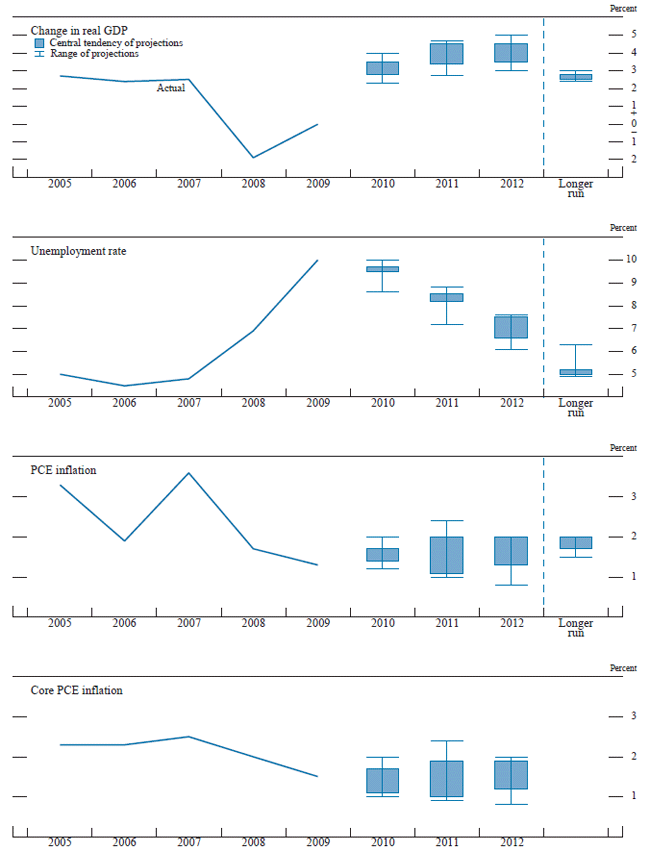
*Accessible version of figure 1 | Return to figure 1 | Return to text
The Outlook
Participants' projections for real GDP growth in 2010 had a central tendency of 2.8 to 3.5 percent, a somewhat narrower interval than in November. Recent readings on consumer spending, industrial production, and business outlays on equipment and software were seen as broadly consistent with the view that economic recovery was under way, albeit at a moderate pace. Businesses had apparently made progress in bringing their inventory stocks into closer alignment with sales and hence would be likely to raise production as spending gained further momentum. Participants pointed to a number of factors that would support the continued expansion of economic activity, including accommodative monetary policy, ongoing improvements in the conditions of financial markets and institutions, and a pickup in global economic growth, especially in emerging market economies. Several participants also noted that fiscal policy was currently providing substantial support to real activity, but said that they expected less impetus to GDP growth from this factor later in the year. Many participants indicated that the expansion was likely to be restrained not only by firms' caution in hiring and spending in light of the considerable uncertainty regarding the economic outlook and general business conditions, but also by limited access to credit by small businesses and consumers dependent on bank-intermediated finance.Looking further ahead, participants' projections were for real GDP growth to pick up in 2011 and 2012; the projections for growth in both years had a central tendency of about 3.5 to 4.5 percent. As in November, participants generally expected that the continued repair of household balance sheets and gradual improvements in credit availability would bolster consumer spending. Responding to an improved sales outlook and readier access to bank credit, businesses were likely to increase production to rebuild their inventory stocks and increase their outlays on equipment and software. In addition, improved foreign economic conditions were viewed as supporting robust growth in U.S. exports. However, participants also indicated that elevated uncertainty on the part of households and businesses and the very slow recovery of labor markets would likely restrain the pace of expansion. Moreover, although conditions in the banking system appeared to have stabilized, distress in commercial real estate markets was expected to pose risks to the balance sheets of banking institutions for some time, thereby contributing to only gradual easing of credit conditions for many households and smaller firms. In the absence of further shocks, participants generally anticipated that real GDP growth would converge over time to an annual rate of 2.5 to 2.8 percent, the longer-run pace that appeared to be sustainable in view of expected demographic trends and improvements in labor productivity.
Participants anticipated that labor market conditions would improve only slowly over the next several years. Their projections for the average unemployment rate in the fourth quarter of 2010 had a central tendency of 9.5 to 9.7 percent, only a little below the levels of about 10 percent that prevailed late last year. Consistent with their outlook for moderate output growth, participants generally expected that the unemployment rate would decline only about 2-1/2 percentage points by the end of 2012 and would still be well above its longer-run sustainable rate. Some participants also noted that considerable uncertainty surrounded their estimates of the productive potential of the economy and the sustainable rate of employment, owing partly to substantial ongoing structural adjustments in product and labor markets. Nonetheless, participants' longer-run unemployment projections had a central tendency of 5.0 to 5.2 percent, the same as in November.
Most participants anticipated that inflation would remain subdued over the next several years. The central tendency of their projections for personal consumption expenditures (PCE) inflation was 1.4 to 1.7 percent for 2010, 1.1 to 2.0 percent for 2011, and 1.3 to 2.0 percent for 2012. Many participants anticipated that global economic growth would spur increases in energy prices, and hence that headline PCE inflation would run slightly above core PCE inflation over the next year or two. Most expected that substantial resource slack would continue to restrain cost pressures, but that inflation would rise gradually toward their individual assessments of the measured rate of inflation judged to be most consistent with the Federal Reserve's dual mandate. As in November, the central tendency of projections of the longer-run inflation rate was 1.7 to 2.0 percent. A majority of participants anticipated that inflation in 2012 would still be below their assessments of the mandate-consistent inflation rate, while the remainder expected that inflation would be at or slightly above its longer-run value by that time.
Uncertainty and Risks
Nearly all participants shared the judgment that their projections of future economic activity and unemployment continued to be subject to greater-than-average uncertainty.19 Participants generally saw the risks to these projections as roughly balanced, although a few indicated that the risks to the unemployment outlook remained tilted to the upside. As in November, many participants highlighted the difficulties inherent in predicting macroeconomic outcomes in the wake of a financial crisis and a severe recession. In addition, some pointed to uncertainties regarding the extent to which the recent run-up in labor productivity would prove to be persistent, while others noted the risk that the deteriorating performance of commercial real estate could adversely affect the still-fragile state of the banking system and restrain the growth of output and employment over coming quarters.As in November, most participants continued to see the uncertainty surrounding their inflation projections as higher than historical norms. However, a few judged that uncertainty in the outlook for inflation was about in line with typical levels, and one viewed the uncertainty surrounding the inflation outlook as lower than average. Nearly all participants judged the risks to the inflation outlook as roughly balanced; however, two saw these risks as tilted to the upside, while one regarded the risks as weighted to the downside. Some participants noted that inflation expectations could drift downward in response to persistently low inflation and continued slack in resource utilization. Others pointed to the possibility of an upward shift in expected and actual inflation, especially if extraordinarily accommodative monetary policy measures were not unwound in a timely fashion. Participants also noted that an acceleration in global economic activity could induce a surge in the prices of energy and other commodities that would place upward pressure on overall inflation.
Diversity of Views
Figures 2.A and 2.B provide further details on the diversity of participants' views regarding the likely outcomes for real GDP growth and the unemployment rate in 2010, 2011, 2012, and over the longer run. The distribution of participants' projections for real GDP growth this year was slightly narrower than the distribution of their projections last November, but the distributions of the projections for real GDP growth in 2011 and in 2012 were little changed. The dispersion in participants' output growth projections reflected, among other factors, the diversity of their assessments regarding the current degree of underlying momentum in economic activity, the evolution of consumer and business sentiment, and the likely pace of easing of bank lending standards and terms. Regarding participants' unemployment rate projections, the distribution for 2010 narrowed slightly, but the distributions of their unemployment rate projections for 2011 and 2012 did not change appreciably. The distributions of participants' estimates of the longer-run sustainable rates of output growth and unemployment were essentially the same as in November.
Table 2. Average historical projection error ranges
Percentage points
| Variable | 2010 | 2011 | 2012 |
|---|---|---|---|
| Change in real GDP1 | ±1.3 | ±1.5 | ±1.6 |
| Unemployment rate1 | ±0.6 | ±0.8 | ±1.0 |
| Total consumer prices2 | ±0.9 | ±1.0 | ±1.0 |
Note: Error ranges shown are measured as plus or minus the root mean squared error of projections for 1989 through 2008 that were released in the winter by various private and government forecasters. As described in the box "Forecast Uncertainty," under certain assumptions, there is about a 70 percent probability that actual outcomes for real GDP, unemployment, and consumer prices will be in ranges implied by the average size of projection errors made in the past. Further information is in David Reifschneider and Peter Tulip (2007), "Gauging the Uncertainty of the Economic Outlook from Historical Forecasting Errors," Finance and Economics Discussion Series 2007-60 (Washington: Board of Governors of the Federal Reserve System, November).
1. For definitions, refer to general note in table 1. Return to table
2. Measure is the overall consumer price index, the price measure that has been most widely used in government and private economic forecasts. Projection is percent change, fourth quarter of the previous year to the fourth quarter of the year indicated. Return to table
Figures 2.C and 2.D provide corresponding information about the diversity of participants' views regarding the inflation outlook. For overall and core PCE inflation, the distributions of participants' projections for 2010 were nearly the same as in November. The distributions of overall and core inflation for 2011 and 2012, however, were noticeably more tightly concentrated than in November, reflecting the absence of forecasts of especially low inflation. The dispersion in participants' projections over the next few years was mainly due to differences in their judgments regarding the determinants of inflation, including their estimates of prevailing resource slack and their assessments of the extent to which such slack affects actual and expected inflation. In contrast, the relatively tight distribution of participants' projections for longer-run inflation illustrates their substantial agreement about the measured rate of inflation that is most consistent with the Federal Reserve's dual objectives of maximum employment and stable prices.
Figure 2.A. Distribution of participants' projections for the change in real GDP, 2010-12 and over the longer run*
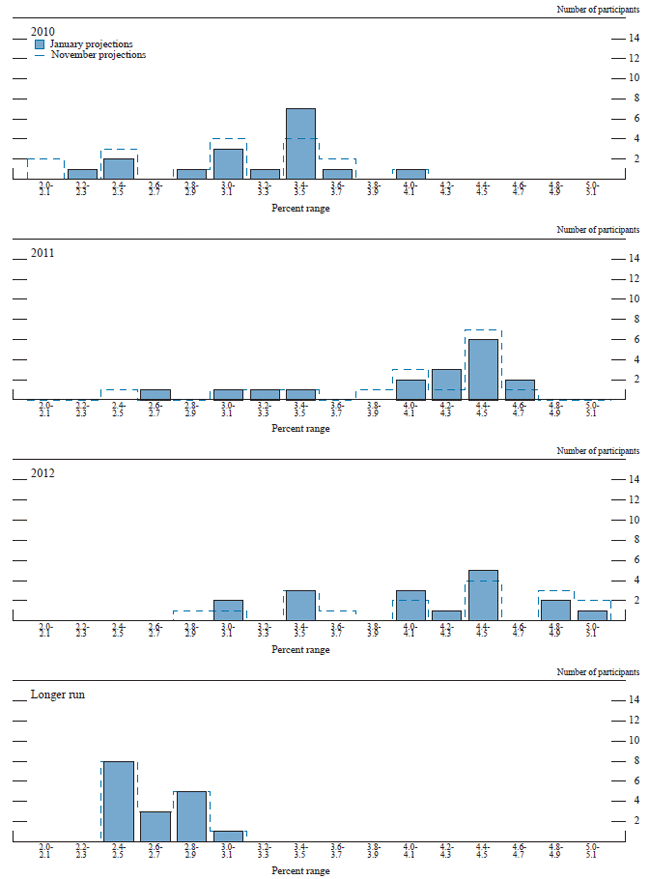
*Accessible version of figure 2.A. | Return to figure 2.A.
Figure 2.B. Distribution of participants' projections for the unemployment rate, 2010-12 and over the longer run*
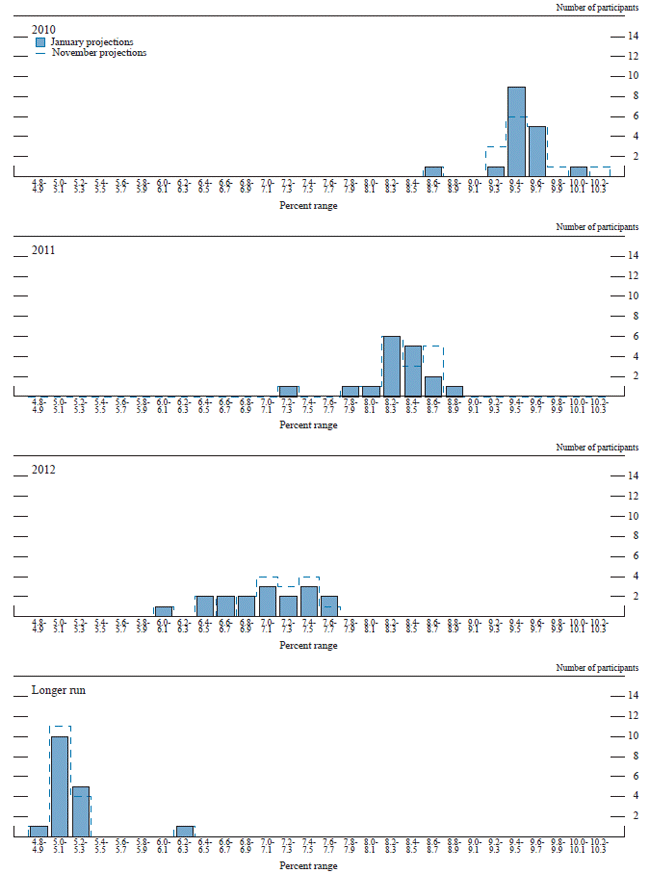
*Accessible version of figure 2.B. | Return to figure 2.B.
Figure 2.C. Distribution of participants' projections for PCE inflation, 2010-12 and over the longer run*
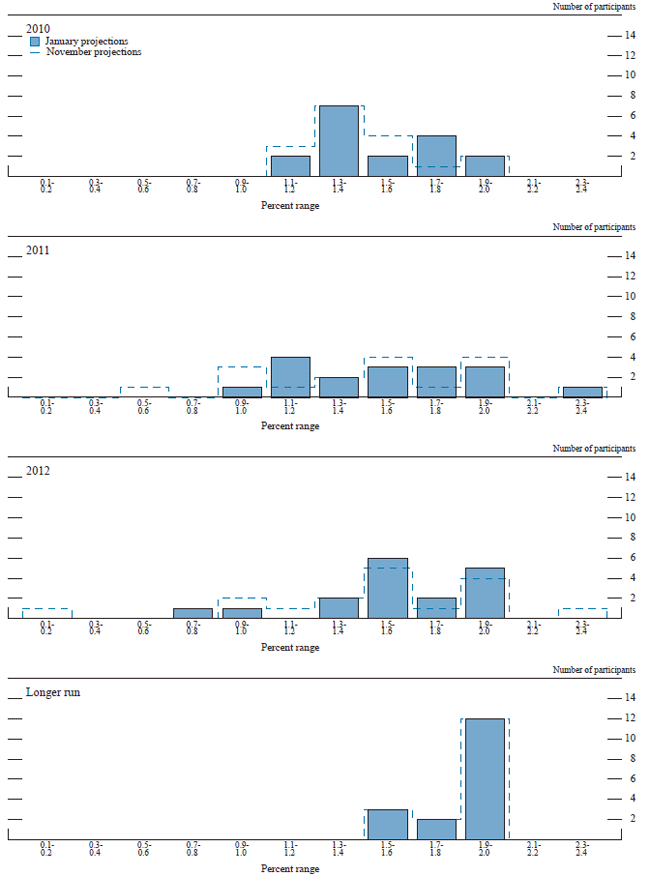
*Accessible version of figure 2.C. | Return to figure 2.C.
Figure 2.D. Distribution of participants' projections for core PCE inflation, 2010-12*
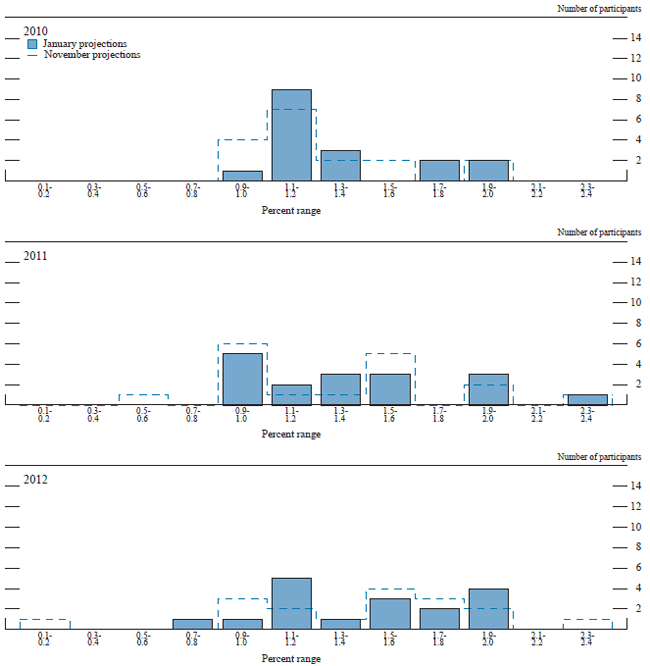
*Accessible version of figure 2.D. | Return to figure 2.D.
Forecast Uncertainty
The economic projections provided by the members of the Board of Governors and the presidents of the Federal Reserve Banks inform discussions of monetary policy among policymakers and can aid public understanding of the basis for policy actions. Considerable uncertainty attends these projections, however. The economic and statistical models and relationships used to help produce economic forecasts are necessarily imperfect descriptions of the real world. And the future path of the economy can be affected by myriad unforeseen developments and events. Thus, in setting the stance of monetary policy, participants consider not only what appears to be the most likely economic outcome as embodied in their projections, but also the range of alternative possibilities, the likelihood of their occurring, and the potential costs to the economy should they occur.
Table 2 summarizes the average historical accuracy of a range of forecasts, including those reported in past Monetary Policy Reports and those prepared by Federal Reserve Board staff in advance of meetings of the Federal Open Market Committee. The projection error ranges shown in the table illustrate the considerable uncertainty associated with economic forecasts. For example, suppose a participant projects that real gross domestic product (GDP) and total consumer prices will rise steadily at annual rates of, respectively, 3 percent and 2 percent. If the uncertainty attending those projections is similar to that experienced in the past and the risks around the projections are broadly balanced, the numbers reported in table 2 would imply a probability of about 70 percent that actual GDP would expand within a range of 1.7 to 4.3 percent in the current year, 1.5 to 4.5 percent in the second year, and 1.4 to 4.6 percent in the third year. The corresponding 70 percent confidence intervals for overall inflation would be 1.1 to 2.9 percent in the current year and 1.0 to 3.0 percent in the second and third years.
Because current conditions may differ from those that prevailed, on average, over history, participants provide judgments as to whether the uncertainty attached to their projections of each variable is greater than, smaller than, or broadly similar to typical levels of forecast uncertainty in the past as shown in table 2. Participants also provide judgments as to whether the risks to their projections are weighted to the upside, are weighted to the downside, or are broadly balanced. That is, participants judge whether each variable is more likely to be above or below their projections of the most likely outcome. These judgments about the uncertainty and the risks attending each participant's projections are distinct from the diversity of participants' views about the most likely outcomes. Forecast uncertainty is concerned with the risks associated with a particular projection rather than with divergences across a number of different projections.
Footnotes
19. Table 2 provides estimates of forecast uncertainty for the change in real GDP, the unemployment rate, and total consumer price inflation over the period from 1989 to 2008. At the end of this summary, the box "Forecast Uncertainty" discusses the sources and interpretation of uncertainty in economic forecasts and explains the approach used to assess the uncertainty and risk attending participants' projections. Return to text
